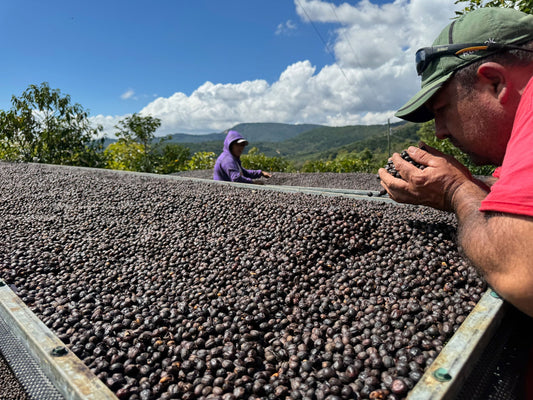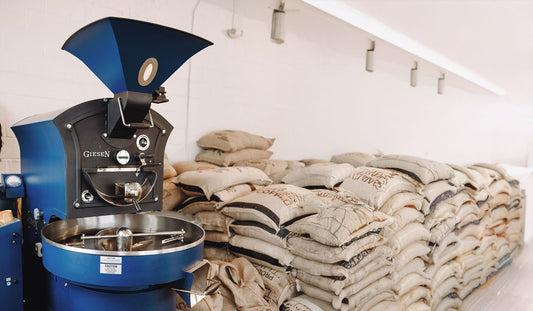Coffee Leaf Rust, a fungus hitting coffee plants hard, is something worth knowing about. Because you love your coffee, right?
This invisible but formidable threat, known as coffee leaf rust or “CLR”, (scientific name: Hemileia vastatrix), is a fungal disease that primarily affects the leaves of coffee plants, manifesting as yellow-orange spots. This causes a premature leaf drop, directly impacting the plant's growth and the development of coffee cherries (no leaves, no photosynthesis). Once infected, the overall health of the coffee plant continues to be compromised, first leading to reduced yield, and in severe cases of infection plant death.
Lifecycle and Spread
CLR's lifecycle is worryingly efficient. The fungus reproduces through spores, which are tiny enough to be carried by wind or rain right into the heart of coffee-producing regions. The moist environments in coffee regions are exactly what the spores need to start their next phase of survival. Once they land, they quickly germinate and penetrate the leaf to start drawing out its nutrients. This process disrupts the plant’s ability to perform photosynthesis, which directly impacts the plant’s ability to produce healthy coffee cherries.
What's more, CLR has a cunning survival mechanism - its ability to reproduce both sexually and asexually. The asexual reproduction during the growing season is what really speeds up its spread, allowing the disease to quickly escalate, catching farmers off guard.
The sexual reproduction side of CLR helps it create a variety of genetic strains. Some of these strains are tougher, even resistant to our current fungicide treatments, which makes this fight against CLR a moving target.
Lessons from Past Crises
When discussing CLR, historical incidents of its outbreaks help reveal its true destructive powers.
Did you know that Sri Lanka’s (then Ceylon) entire coffee industry collapsed in the 19th century due to coffee leaf rust? At the peak of its coffee production, Sri Lanka had over 400,000 acres dedicated to coffee plantations. Coffee production was a significant part of the island's economy, but within a decade of CLR's arrival, production had dropped by 90%. This was not an agricultural crisis. This was an economic disaster. Thousands of farmers, who once prospered from coffee cultivation, found themselves facing extreme poverty, unemployment, and a drastic shift in their agricultural future. Through many years of subsequent trial-and-error, Sri Lanka eventually turned to tea cultivation, which ended up ensuring the future of next-generation Sri Lankan farmers.
Today the story of Sri Lanka’s coffee collapse is a good example, one of fragility of monocultural economies and the devastating impact of spreadable agricultural diseases.
Similar incidents have even occurred in regions like Central America more recently. In 2012, Guatemala declared a national emergency when CLR affected over 70% of its coffee farms. The country faced about a 25% drop in national coffee production. Countless farming families were devastated, with zero alternatives.
Personal Accounts
It’s worth mentioning that inspiring stories and lessons to tackle this fungus are also out there.
On our 2016 visit to a remote farm in Honduras, which was severely hit by CLR several years back, we learned the valuable lesson of optimizing airflow to reduce fungal growth conditions. This one technique alone not only saved this particular farm from CLR, but consistently helped our team to use it as a case-study for helping farmers in other countries.
In Colombia, we remember meeting Juan, who had decided to solely stick to organic practices on his farm. By improving his techniques, and the health of his plants and the surrounding biodiversity, he clearly witnessed fewer incidences of CLR on his farm in comparison to neighboring areas.
Climate Change is Also an Aggravating Factor
The challenge of managing CLR is definitely compounded by climate change. Rising temperatures and altered precipitation patterns create more favorable conditions for CLR (warmer and more humid environments facilitate fungal growth). For farmers, this demands adaptive farming practices, and for researchers, the development of climate-resilient coffee varieties perhaps. Though sustainable farming practices, such as shade cultivation and the introduction of biodiversity, are continuously being adopted with visible success against diseases like CLR.
We All Play an Important Part
As consumers, our purchasing decisions have the power to influence the coffee industry's approach to dealing with CLR. Choosing coffees sourced from farms that prioritize sustainable practices can drive demand for more resilient coffee production methods. This “consumer-driven approach” is one important way to steer on-going research efforts on CLR towards more sustainable thinking.



